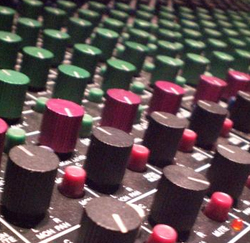In previous articles in this series (here), we’ve spent considerable time on EQ and gain, but this time we’re going to pick it up a little bit and cover a number of other buttons and knobs that typically exist on each channel. These all exist on a digital console too, but may not be in the same order as we’ll tackle them here.
PAD
Most of the time you won’t likely need this, but occasionally inputs send a much stronger signal than usual and you run out of room to turn the gain down. Engaging this button will provide a cushion, usually 20 dB, which supplies room to go up or down with gain without having way too much input.
Phantom Power (48V)
Phantom power is required to operate certain types of microphones and is usually supplied by the mixing console. While we’re not looking to cover all types of microphones in this article, we’ll make a distinction between dynamic and condenser mics for the sake of our discussion on phantom power.
Dynamic microphones like the Shure SM57 and SM58 are relatively inexpensive, durable, moisture-resistant and less prone to feedback. Condenser microphones tend to produce a higher quality sound (flatter and extended frequency response) and are more sensitive to picking up sound.
Condenser microphones are good at picking up more of the detail and nuance of acoustic instruments and vocals. They also require power, and that’s where our “48V” button, otherwise known as phantom power, comes in. You might have the gain set correctly and the fader set to a normal level, but if the phantom power is not turned on, there won’t be sound from condenser mics.
AUX (or Mix)
Just as faders are used to mix the house send, the Aux sends are simply another mix that can be put together. Working the exact same way the faders do to create a mix, turn the AUX knobs to increase or decrease the level of input sources into each mix.
For most people, Aux sends will feed monitor wedges, in-ears or effects. Regardless of where the final send goes, AUX sends are simply a different way to mix inputs into an output.
PAN
If mixing a stereo house, one where both the left and right loudspeaker can be heard from most seats in the house, the pan knob can help in creating a little bit of space in the mix and create a stereo image for those listening.
When operating with a mono system, or a stereo system where each side of the house only hears one of the loudspeakers, it’s best to leave the pan knob at center so everyone gets to hear the entire mix.
MUTE
Simple enough, this button will eliminate that channel’s audio from its output destination. On some consoles (Yamaha especially), the mute button is replaced with an “on” button. In that case, switching the “onn” button off will eliminate audio.
PFL/AFL/Solo
Primarily known as Pre-Fader Listen and After Fader Listen, this button is also known as Solo. Pressing it providesthe opportunity to monitor only that input in your headphones for checking for anomalies or other specific things you’re hearing.
Some mixers have a Solo with the ability to choose whether to hear the solo pre-fader (the input right as it comes into the mixer and after the gain knob) or post-fader (the input with channel strip processing and the channel fader volume applied).
Assign/Subgroups
The assign buttons allow you to route the signal or sound of that channel directly to the master output or to a subgroup. The more technical term for a mixers subgroup is VCA (Voltage Controlled Amplifier) and the digital mixer version is DCA (Digital Control Amplifier).
When mixing 24-48 inputs, it can be tough to keep up with the dynamics of all the live musicians when dealing with each fader individually. Creating relevant groups by assigning multiple channels to a single subgoup allows you to adjust that group of channels with just one fader.
For example, let’s say we have eight inputs for our drums, bass, acoustic, electric, two stereo keyboards, a variety of orchestra instruments, six vocalists and a choir. In order to make mixing all of those inputs more manageable, we’ll assign them to the subgroups.
One possible breakdown for grouping could be:
1) Drums
2) Guitars
3) Keyboards
4) Orchestra
5) Lead Vocals
6) Background Vocals
7) Choir
8) Playback sources (CD, i-device, DVD player, etc.)
While you may prefer a slightly different arrangement (which is fine), right off the bat mixing has been streamlined through the use of subgroups. Finding that background vocals are getting a bit lost, but the blending of them is solid? Just push up the entire group a bit.
When you hitting that big accapella section of the song with just the drums, push just the drums and vocals a bit with two faders instead of grabbing 12. If one song is guitar led and the next one is keyboard led, make that adjustment quickly as well, without changing the overall balance of what is in each group.
If you’re going to be an active sound person (and I hope you are), assigning inputs to subgroups will help make group changes quickly.
Next time: what goes into creating an effective mix.
Duke DeJong has more than 12 years of experience as a technical artist, trainer and collaborator for ministries. CCI Solutions is a leading source for AV and lighting equipment, also providing system design and contracting as well as acoustic consulting. Find out more here.























